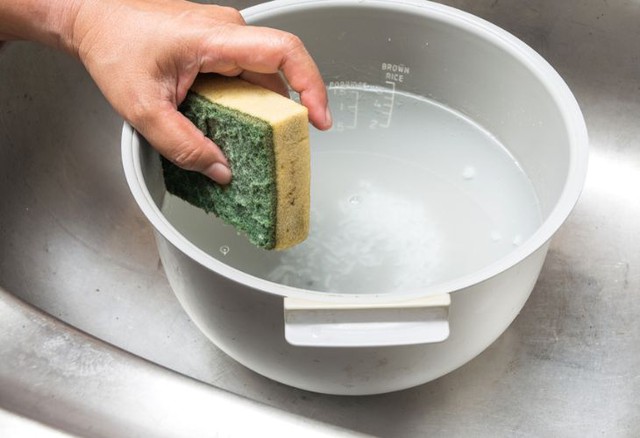How to Properly Care for Your Rice Cooker and Avoid Common Mistakes
Rice cookers are a familiar kitchen appliance in many households, helping users save time and effort in cooking rice. They also produce delicious, fluffy, and fragrant rice.
Operating a rice cooker is generally simple and easy. However, there is a basic step that not everyone does correctly. In fact, many people make a mistake every day when it comes to cleaning their rice cooker.

Illustration photo
A common practice is to soak the inner pot in cold water immediately after use, then wait a few minutes before washing it with dish soap. During washing, one may choose to use a scouring pad, sponge, or mesh scrubber…
However, the aboluowang website recently pointed out that this practice may not be correct. Specifically, soaking the hot inner pot in cold water can damage the non-stick coating inside. In addition, soaking in cold water may not be effective and can prolong the soaking time. Soaking the pot for too long can also affect its quality.
Therefore, instead of using cold water, users should switch to using warm or hot water to soak the pot. Do not use boiling water or water that is too hot, as the sudden change in temperature can deform the pot or cause the non-stick coating to peel off. The ideal time to soak the pot is to let it cool down relatively, about 20-30 minutes after use.

Do not soak the inner pot immediately after use, wait until it cools down and then soak it in warm water (Illustration photo)
After the soaking time of about 10-15 minutes, proceed to wash the rice cooker as usual. You can use clean water with a mild detergent, or use natural ingredients such as lemon or orange peels to clean the appliance.
Especially, another important note when cleaning the inner pot of the rice cooker is to never use metal scouring pads. Just like non-stick pans and pots, the entire inner surface of the rice cooker is coated with a non-stick layer to help cook better rice.
Using metal scouring pads to scrub stubborn rice residue can accidentally scratch the non-stick coating, reducing the lifespan of the appliance. In addition, scratches can release microplastics, which can be harmful to human health when in contact with food.

Do not use metal scouring pads to clean the inner pot of the rice cooker (Illustration photo)
Other Common Mistakes When Using a Rice Cooker
In addition to cleaning, many users also make mistakes during the use of the rice cooker, unintentionally causing it to break down faster, and the rice to be less tasty, fluffy, and evenly cooked. Let’s take a look at some common mistakes and try to avoid them.
1. Not drying the bottom of the inner pot
The first common mistake is not drying the bottom of the inner pot before cooking. This can damage the rice cooker’s thermal relay. Water left at the bottom of the pot can cause scorching, blackening of the pot and heating plate, and even short circuits during use.
Therefore, before using the rice cooker, make sure to use a soft cloth or paper towel to dry the water from the entire outer surface of the pot, including the bottom and edges. This will ensure safe and efficient use.

Illustration photo
2. Washing rice directly in the inner pot
Many people also tend to wash rice directly in the inner pot for convenience and to save time. However, for rice cookers with non-stick coatings, it is best to avoid this practice.
Washing rice directly in the pot can scratch the non-stick coating. Therefore, it is recommended to wash the rice separately in a basket or small basin and then put it back into the pot with water to cook.

Illustration photo
3. Using metal utensils to scoop rice
Do not use metal spoons, forks, or knives to scoop rice from the rice cooker out of convenience. The strong impact of metal utensils can damage or deteriorate the non-stick coating inside the rice cooker.
In all cases, only use wooden or plastic utensils with a round head to scoop rice from the rice cooker. This is why every rice cooker comes with its own dedicated scoop.

Illustration photo
4. Improper storage of the rice cooker
Finally, it is important to properly store the rice cooker after cleaning and washing. Do not stack other objects on top of the rice cooker, especially inside the inner pot. Instead, store the rice cooker in a separate area, allowing the inner pot to dry completely, and use a soft cloth to wipe the outer shell before putting it back in its designated place.









